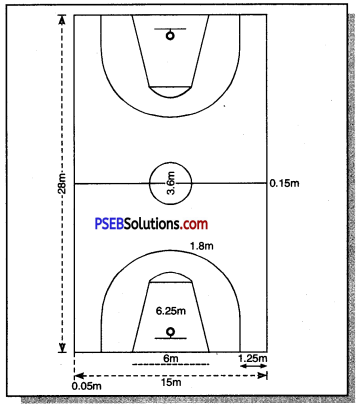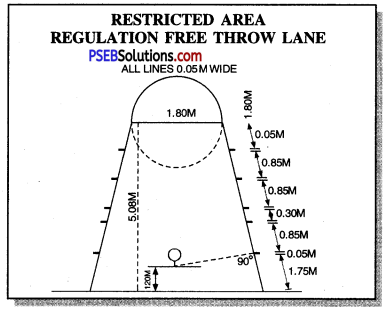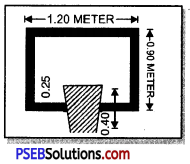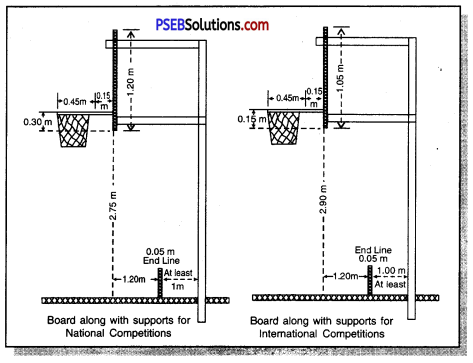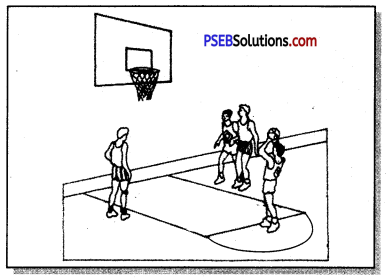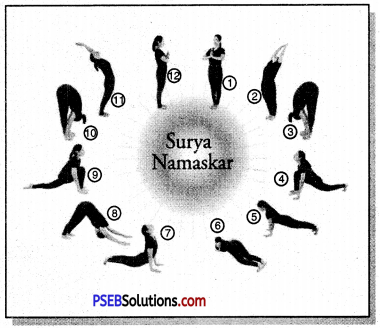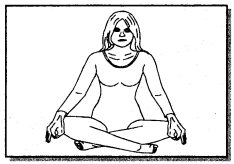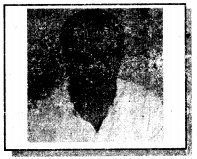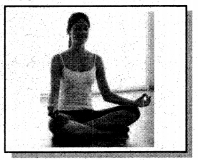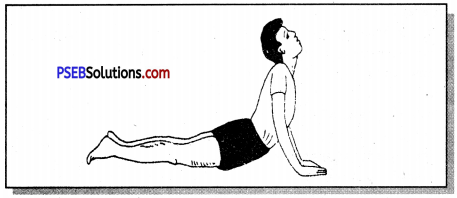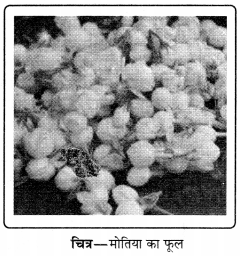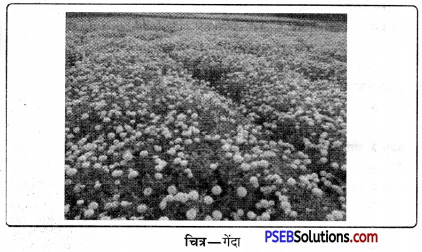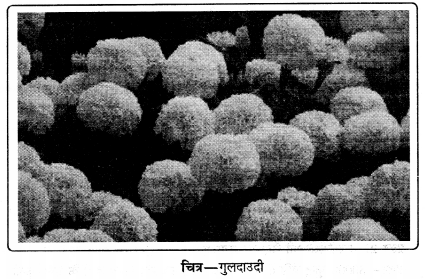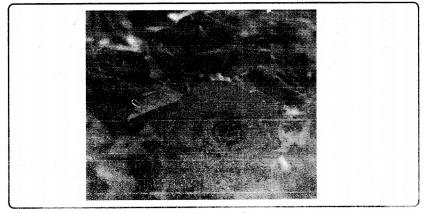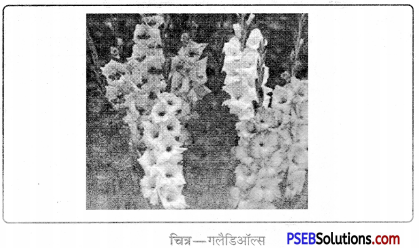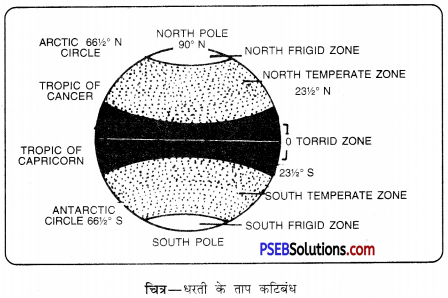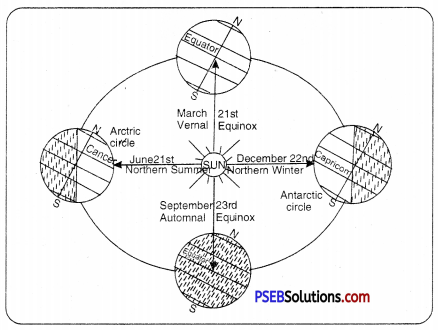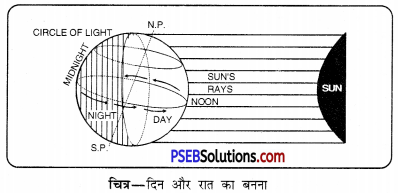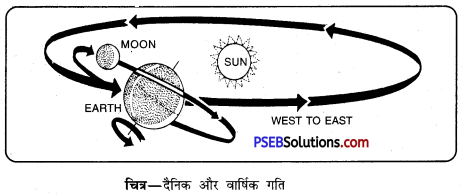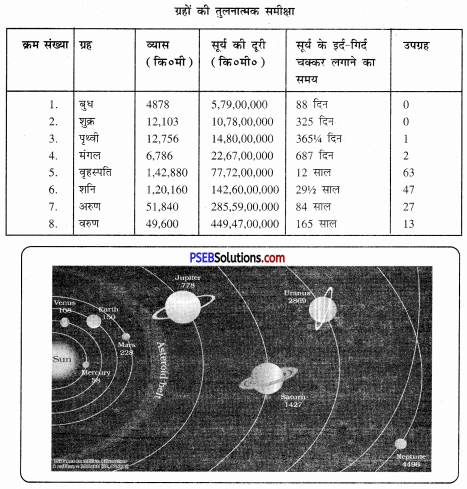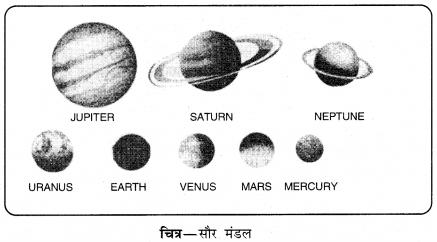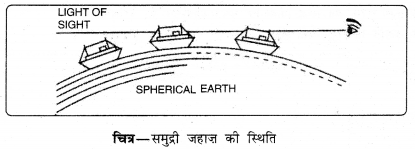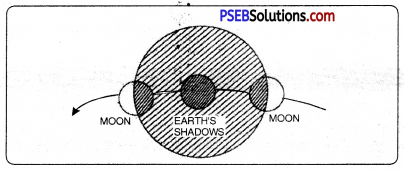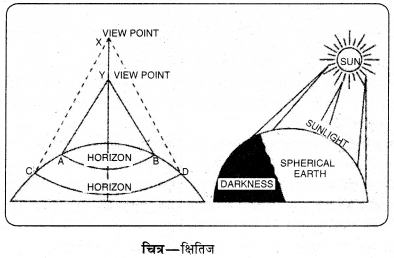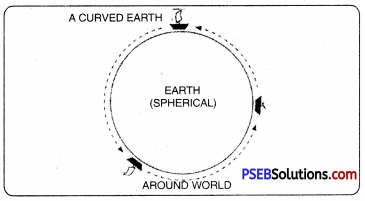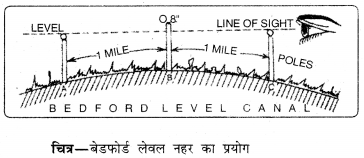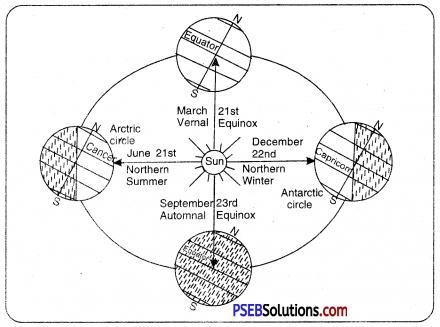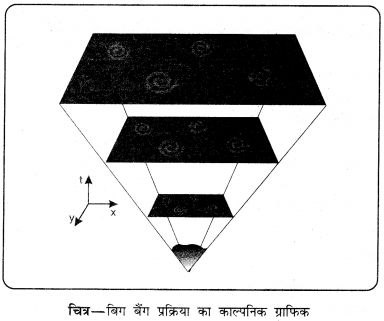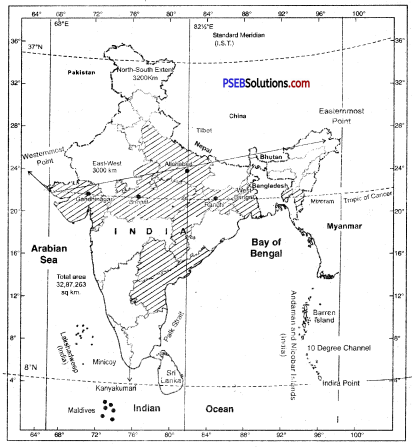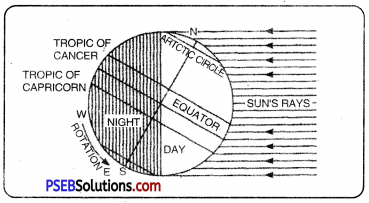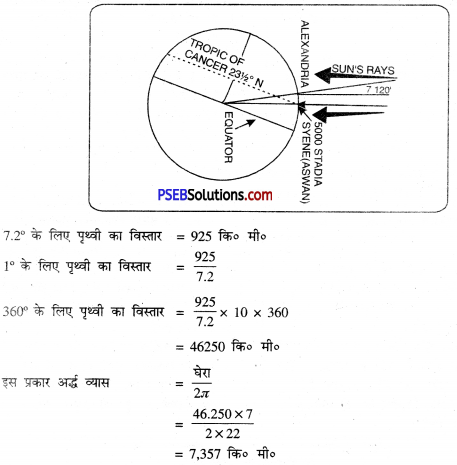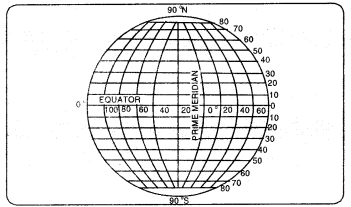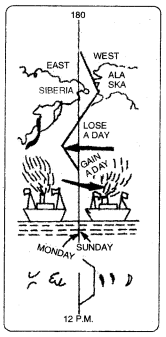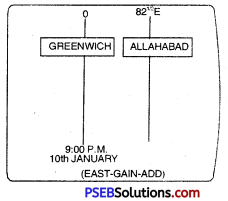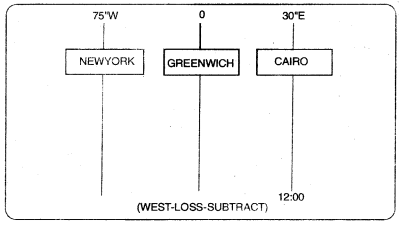Punjab State Board PSEB 11th Class Political Science Book Solutions Chapter 28 संघीय कार्यपालिका–प्रधानमन्त्री तथा मन्त्रिपरिषद् Textbook Exercise Questions and Answers.
PSEB Solutions for Class 11 Political Science Chapter 28 संघीय कार्यपालिका–प्रधानमन्त्री तथा मन्त्रिपरिषद्
दीर्घ उत्तरीय प्रश्न-
प्रश्न 1.
भारत के प्रधानमन्त्री की स्थिति की संक्षेप में विवेचना कीजिए।
(Describe in brief the position of the Prime Minister.)
अथवा
भारत के प्रधानमन्त्री की नियुक्ति कैसे होती है ? उसकी शक्तियों और स्थिति का वर्णन करो।
(How is Prime Minister of India appointed ? Discuss his powers and position.)
अथवा
भारत के प्रधानमन्त्री की नियुक्ति किस प्रकार होती है ? उसके मन्त्रिपरिषद् और राष्ट्रपति के साथ सम्बन्धों का वर्णन करो।
(How is the Prime Minister of India appointed ? Discuss his relations with the Council of Ministers and the President.)
उत्तर-
भारतीय संविधान के अनुच्छेद 74 के अन्तर्गत राष्ट्रपति की सहायता के लिए एक मन्त्रिपरिषद् की व्यवस्था की गई है जिसकी अध्यक्षता प्रधानमन्त्री करता है। भारत के राज्य प्रबन्ध में प्रधानमन्त्री को बड़ा महत्त्वपूर्ण स्थान प्राप्त है। चाहे संविधान द्वारा राष्ट्रपति को मुख्य कार्यपालक (Chief Executive Head of the State) नियुक्त किया गया है, किन्तु व्यावहारिक रूप में मुख्य कार्यपालिका के सब कार्य प्रधानमन्त्री ही करता है।
प्रधानमन्त्री की नियुक्ति (Appointment of the Prime Minister)-संविधान में कहा गया है कि प्रधानमन्त्री की नियुक्ति राष्ट्रपति करेगा, परन्तु वास्तव में ऐसा नहीं है। देश में संसदीय प्रणाली होने के कारण राष्ट्रपति अपनी इच्छानुसार किसी भी व्यक्ति को प्रधानमन्त्री नियुक्त नहीं कर सकता। वह केवल उसी व्यक्ति को प्रधानमन्त्री नियुक्त कर सकता है जो लोकसभा में बहुमत दल वाली पार्टी का नेता चुना गया हो। दिसम्बर, 1984 में लोकसभा के चुनाव में कांग्रेस (आई) को भारी बहुमत प्राप्त हुआ और राष्ट्रपति ने कांग्रेस (आई) के नेता श्री राजीव गांधी को प्रधानमन्त्री नियुक्त किया। परन्तु कुछ परिस्थितियों में राष्ट्रपति को अपनी इच्छा का प्रयोग करने का अवसर मिल जाता है। ये परिस्थितियां निम्नलिखित हैं-
- जब लोकसभा में किसी भी राजनीतिक पार्टी को स्पष्ट बहुमत प्राप्त न हो, अथवा
- कुछ दल मिलकर संयुक्त सरकार का निर्माण (Coalition Ministry) न कर सकें, अथवा
- लोकसभा में दो दलों को समान प्रतिनिधित्व प्राप्त हो।
- जब प्रधानमन्त्री की अचानक मृत्यु हो जाए।
उपर्युक्त परिस्थितियों में राष्ट्रपति अपने विवेक, बुद्धि तथा उच्च सूझ-बूझ से काम लेते हुए अपनी इच्छानुसार किसी भी दल के नेता को, जिसे वह स्थायी सरकार बनाने के योग्य समझता हो, मन्त्रिमण्डल बनाने के लिए निमन्त्रण दे सकता है। 15 जुलाई, 1979 को प्रधानमन्त्री मोरारजी देसाई के त्याग-पत्र देने पर किसी भी दल को लोकसभा में स्पष्ट बहुमत प्राप्त नहीं था। अतः राष्ट्रपति संजीवा रेड्डी ने अपनी सूझबूझ के अनुसार विपक्ष के नेता यशवन्तराय चह्वाण को सरकार बनाने का निमन्त्रण दिया। परन्तु उसने सरकार बनाने में असमर्थता जाहिर की। उसके बाद राष्ट्रपति ने चौधरी चरण सिंह और मोरारजी देसाई को अपने समर्थकों की सूची देने को कहा और अन्त में 26 जुलाई, 1979 को राष्ट्रपति ने चौधरी चरण सिंह को प्रधानमन्त्री नियुक्त किया और उसे सरकार बनाने को कहा। 31 अक्तूबर, 1984 को प्रधानमन्त्री इन्दिरा गांधी की हत्या होने के कुछ समय बाद राष्ट्रपति ज्ञानी जैल सिंह ने अपनी इच्छा से श्री राजीव गांधी को प्रधानमन्त्री नियुक्त किया। 1 अप्रैल-मई, 1996 के लोकसभा के चुनाव में किसी भी पार्टी को बहुमत प्राप्त नहीं हुआ।
राष्ट्रपति ने लोकसभा में सबसे बड़ी पार्टी भारतीय जनता पार्टी के नेता अटल बिहारी वाजपेयी को प्रधानमन्त्री नियुक्त किया। प्रधानमन्त्री अटल बिहारी वाजपेयी ने 28 मई, 1996 को त्याग-पत्र दे दिया क्योंकि लोकसभा में उन्हें बहुमत का समर्थन प्राप्त नहीं था। 1 जून, 1996 को राष्ट्रपति ने संयुक्त मोर्चा के नेता एच० डी० देवेगौड़ा को प्रधानमन्त्री नियुक्त किया, क्योंकि कांग्रेस ने देवेगौड़ा को समर्थन देने का वायदा किया था। प्रधानमन्त्री देवेगौड़ा ने 12 जून, 1996 को लोकसभा में बहुमत का विश्वास प्राप्त किया। मार्च, 1998, में 12वीं लोकसभा के चुनाव में किसी भी पार्टी अथवा चुनावी गठबन्धन को स्पष्ट बहुमत न मिलने पर राष्ट्रपति ने लोकसभा में सबसे बड़ी पार्टी भारतीय जनता पार्टी तथा उसके सहयोगी दलों के नेता अटल बिहारी वाजपेयी को प्रधानमन्त्री नियुक्त किया। प्रधानमन्त्री अटल बिहारी वाजपेयी ने 28 मार्च, 1998 को लोकसभा में विश्वास मत प्राप्त किया। सितम्बर-अक्तूबर, 1999 में हुए 13वीं लोकसभा के चुनावों में 24 दलों वाले राष्ट्रीय जनतान्त्रिक गठबन्धन को बहुमत प्राप्त हुआ।
अतः राष्ट्रपति के० आर० नारायणन ने इस गठबन्धन के नेता श्री अटल बिहारी वाजपेयी को प्रधानमन्त्री नियुक्त किया। अप्रैल-मई, 2004 में हुए 14वीं लोकसभा के चुनाव में किसी भी दल को बहुमत प्राप्त नहीं हुआ। अतः राष्ट्रपति डॉ० ए० पी० जे० अब्दुल कलाम ने कांग्रेस के नेतृत्व में बने संयुक्त प्रगतिशील गठबन्धन के नेता डॉ मनमोहन सिंह को प्रधानमन्त्री नियुक्त किया। अप्रैल-मई, 2014 में हुए 16वीं लोक सभा के चुनावों के बाद भारतीय जनता पार्टी के नेता श्री नरेन्द्र मोदी को प्रधानमन्त्री नियुक्त किया गया।
![]()
प्रधानमन्त्री की योग्यताएं (Qualifications of the Prime Minister)-प्रधानमन्त्री की योग्यताओं का वर्णन संविधान में नहीं किया गया है, क्योंकि प्रधानमन्त्री के लिए संसद् का सदस्य होना आवश्यक है। इसलिए संसद् सदस्यों की योग्यताएं तथा अयोग्यताएं उस पर लागू होती हैं। इसके अतिरिक्त मन्त्रिमण्डलीय उत्तरदायित्व के सिद्धान्त के अन्तर्गत उसे लोकसभा में बहुमत का विश्वास प्राप्त होना चाहिए अर्थात् उसे बहुमत पार्टी का नेता होना चाहिए। व्यावहारिक रूप में उसमें व्यक्तिगत गुणों का होना आवश्यक है। जिस प्रकार ब्रिटेन के वाल्डविन के व्यक्तित्व में पाइप (Pipe) तथा चर्चिल के व्यक्तित्व में सिगार (Cigar) ने निखार ला दिया था, उसी प्रकार भारत में श्री नेहरू की प्रतिभा में गुलाब का फूल, श्री लाल बहादुर शास्त्री के व्यक्तित्व में उनकी सादगी, श्रीमती इन्दिरा गांधी की लोकप्रियता में उनका मनमोहक व्यक्तित्व और राजीव गांधी के व्यक्तित्व में उनका भोलापन और अच्छा आचरण चार चांद लगा देता था।
अवधि (Term)-साधारण रूप में प्रधानमन्त्री के पद की अवधि राष्ट्रपति की कृपादृष्टि पर आधारित है तथा इसका कार्यकाल 5 वर्ष समझा जाता है, परन्तु वास्तव में यह बात नहीं है। इसकी अवधि लोकसभा के बहुमत के समर्थन पर निर्भर करती है। जब प्रधानमन्त्री के पक्ष में लोकसभा का बहुमत नहीं रहता तथा उसके विरुद्ध अविश्वास का मत स्वीकार हो जाता है, तब प्रधानमन्त्री को त्याग-पत्र देना पड़ता है। प्रधानमन्त्री का त्याग-पत्र सम्पूर्ण मन्त्रिमण्डल का त्याग-पत्र समझा जाता है। 28 मई, 1996 को प्रधानमन्त्री अटल बिहारी वाजपेयी ने अपने पद से त्याग-पत्र दे दिया क्योंकि वे लोकसभा में बहुमत का समर्थन प्राप्त नहीं कर सके। वे केवल 13 दिन तक भारत के प्रधानमन्त्री रहे। प्रधानमन्त्री वाजपेयी ने 17 अप्रैल, 1999 को त्याग-पत्र दे दिया क्योंकि वे लोकसभा में बहुमत का समर्थन प्राप्त न कर सके।
वेतन (Salary)-प्रधानमन्त्री को 1987 के अधिनियम के अनुसार वही वेतन और भत्ते मिलते हैं जो संसद् के सदस्य को मिलते हैं।
प्रधानमन्त्री के कार्य तथा शक्तियां (Powers and Functions of the Prime Minister)—प्रधानमन्त्री की शक्तियां एवं कार्य निम्नलिखित हैं-
1. मन्त्रिमण्डल का नेता (Leader of the Cabinet)-प्रधानमन्त्री मन्त्रिमण्डल का नेता है। मन्त्रिमण्डल को बनाने वाला और नष्ट करने वाला प्रधानमन्त्री ही है। वास्तव में मन्त्रिमण्डल का प्रधानमन्त्री के बिना कोई अस्तित्व नहीं है। यही कारण है कि उसे “मन्त्रिमण्डल रूपी मेहराब की आधारशिला” (“Key-stone of the Cabinet arch.’) कहा गया है। प्रधानमन्त्री को मन्त्रिमण्डल से सम्बन्धित निम्नलिखित कार्य करने पड़ते हैं :-
(क) प्रधानमन्त्री मन्त्रिपरिषद् का निर्माण करता है (Formation of the Council of Ministers)राष्ट्रपति प्रधानमन्त्री के परामर्श से मन्त्रिपरिषद् के अन्य मन्त्रियों की नियुक्ति करता है। इस सम्बन्ध में प्रधानमन्त्री अपने साथी मन्त्रियों के नाम राष्ट्रपति की स्वीकृति के लिए प्रस्तुत करता है तथा उसकी स्वीकृति प्राप्त होने के पश्चात् वे मन्त्री बन जाते हैं। क्योंकि राष्ट्रपति की स्वीकृति एक औपचारिक कार्यवाही है, इसलिए मन्त्रियों की नियुक्ति की वास्तविक शक्ति प्रधानमन्त्री के पास ही है। 91वें संविधान संशोधन अधिनियम 2003 के अनुसार मन्त्रिपरिषद् में प्रधानमन्त्री सहित मन्त्रियों की कुल संख्या लोकसभा के सदस्यों की कुल संख्या के 15% से अधिक नहीं होनी चाहिए। सितम्बर, 2017 में मन्त्रिपरिषद् की सदस्य संख्या 75 थी।
(ख) विभागों का विभाजन (Allocation of Portfolios)-प्रधानमन्त्री अपने साथियों को चुनता ही नहीं अपितु उनमें विभागों का विभाजन भी करता है। वह किसी भी मन्त्री को कोई भी विभाग दे सकता है तथा इसमें परिवर्तन भी कर सकता है। सितम्बर, 2017 में प्रधानमंत्री श्री नरेन्द्र मोदी ने अपनी मंत्रिपरिषद् का विस्तार एवं पुनर्गठन किया, इससे मंत्रिपरिषद् की सदस्य संख्या 75 हो गई। इसमें 27 कैबिनेट मंत्री 37 राज्यमंत्री तथा 11 स्वतंत्र प्रभार वाले राज्यमंत्री शामिल थे।
(ग) प्रधानमन्त्री मन्त्रिमण्डल का सभापति (Chairman of the Cabinet)-प्रधानमन्त्री मन्त्रिमण्डल का सभापति होता है। वह कैबिनेट की बैठकों में सभापतित्व करता है। वह कार्यसूची तैयार करता है। बैठकों में होने वाले वाद-विवाद पर नियन्त्रण रखता है। मन्त्रिमण्डल के अधिकतर निर्णय वास्तव में प्रधानमन्त्री के ही निर्णय होते हैं।
(घ) मन्त्रियों की पदच्युति (Removal of the Ministers)-संविधान के अनुसार मन्त्री राष्ट्रपति की प्रसन्नता तक अपने पद पर रहते हैं, परन्तु वास्तव में मन्त्री तब तक अपने पद पर रह सकते हैं जब तक प्रधानमन्त्री चाहे । उसकी इच्छा के विरुद्ध कोई भी व्यक्ति मन्त्रिपरिषद् में नहीं रह सकता। यदि कोई मन्त्री प्रधानमन्त्री के कहने के अनुसार त्यागपत्र न दे तो वह राष्ट्रपति को कहकर उसे पदच्युत करवा सकता है और दोबारा मन्त्रिमण्डल का निर्माण करते समय अपने विरोधी व्यक्तियों को मन्त्रिमण्डल से बाहर रख सकता है।
1 अगस्त, 1990 को प्रधानमन्त्री वी० पी० सिंह की सलाह से राष्ट्रपति द्वारा उप प्रधानमन्त्री देवी लाल को केन्द्रीय मन्त्रिमण्डल की सलाह से हटा दिया गया। जुलाई, 1992 को वाणिज्य मन्त्री पी. चिदम्बरम ने प्रतिभूति घोटाले के आरोप में दोषी ठहराए जाने के कारण अपना त्याग-पत्र प्रधानमन्त्री को दे दिया। जनवरी-फरवरी, 1996 में 6 केन्द्रीय मन्त्रियों ने हवाला कांड में शामिल होने के कारण त्यागपत्र दे दिए। 20 अप्रैल, 1998 को प्रधानमन्त्री वाजपेयी ने त्याग-पत्र देने से इन्कार करने पर संचार मन्त्री बूटा सिंह को बर्खास्त कर दिया। इस प्रकार प्रधानमन्त्री को मन्त्रियों को हटाने का पूरा अधिकार प्राप्त है।
2. प्रधानमन्त्री का समन्वयकारी रूप (Prime Minister as a Co-ordinator)—प्रधानमन्त्री सरकार के भिन्न-भिन्न विभागों तथा उनके कार्यों में ताल-मेल रखता है। वह मन्त्रिमण्डल में एकता तथा सामूहिक उत्तरदायित्व स्थापित करता है। विभिन्न विभागों में जब मतभेद उत्पन्न हो जाते हैं तब प्रधानमन्त्री ही उनको हल करता है।
3. योग्य सरकार के लिए उत्तरदायी (Responsible for able Government)-प्रधानमन्त्री सरकार की योग्यता के लिए उत्तरदायी है। उसको सदा यह ध्यान रखना पड़ता है कि उसकी सरकार तथा पार्टी की देश में साख बनी रहे। इस उत्तरदायित्व को निभाने हेतु वह अपने मन्त्रिमण्डल में समय-समय पर परिवर्तन भी कर सकता है। नवीन मन्त्रियों को नियुक्त कर सकता है तथा यदि ऐसा अनुभव करे कि किसी विशेष मन्त्री का मन्त्रिमण्डल में होना सरकार के हित में अथवा मान में नहीं है तो वह ऐसे मन्त्री को पद से हटा भी सकता है।
4. राष्ट्रपति का मुख्य सलाहकार (Principle Adviser of the President)-प्रधानमन्त्री राष्ट्रपति का मुख्य सलाहकार है। राष्ट्रपति प्रशासन के प्रत्येक मामले पर प्रधानमन्त्री की सलाह लेता है। राष्ट्रपति को प्रधानमन्त्री की सलाह के अनुसार ही शासन चलाना पड़ता है। राष्ट्रपति सीधा मन्त्रियों से बात न करके प्रधानमन्त्री के माध्यम से ही मन्त्रिमण्डल की सलाह लेता है।
5. राष्ट्रपति तथा मन्त्रिमण्डल में एक महत्त्वपूर्ण कड़ी (Link between the President and the Cabinet)प्रधानमन्त्री, राष्ट्रपति तथा मन्त्रिमण्डल के मध्य एक कड़ी का कार्य करता है। वह राष्ट्रपति को मन्त्रिमण्डल के निर्णयों के विषय में सूचित करता है। मन्त्री, प्रधानमन्त्री की पूर्व स्वीकृति में राष्ट्रपति से मिल सकते हैं, परन्तु औपचारिक रूप में प्रधानमन्त्री ही राष्ट्रपति को मन्त्रिमण्डल के सभी निर्णयों से सूचित करता है।
6. सरकार का मुखिया (Head of the Govt.) सरकार का मुखिया होने के नाते प्रधानमन्त्री राज्य प्रबन्ध चलाता है। गृह तथा विदेश नीति का निर्माण करता है। वह समस्त महान् नीतियों की मन्त्रिमण्डल की ओर से घोषणा भी करता है। बजट भी उसकी देख-रेख में तैयार होता है। राष्ट्रपति प्रधानमन्त्री की सहमति के बिना न कोई नियुक्ति करता है तथा न ही कोई उपाधि देता है।
7. सरकार का प्रमुख प्रवक्ता (Chief Spokesman of the Government)-प्रधानमन्त्री ही सरकार का प्रमुख प्रवक्ता है। संसद् तथा जनता के सामने मन्त्रिमण्डल की नीति और निर्णयों की घोषणा प्रधानमन्त्री द्वारा की जाती है। वह सभी प्रशासकीय विभागों की जानकारी रखता है। जब कभी कोई मन्त्री संकट में हो तो उसकी सहायता करके मन्त्रिमण्डल-रूपी नौका को डूबने से बचाने का काम प्रधानमन्त्री ही करता है।
8. संसद् का नेता (Leader of the Parliament)—प्रधानमन्त्री को संसद् का नेता माना जाता है। सरकार की नीतियों की सभी महत्त्वपूर्ण घोषणाएं प्रधानमन्त्री द्वारा की जाती हैं। जब संसद् के सामने कोई समस्या आ खड़ी होती है तब वह प्रधानमन्त्री की ओर पथ-प्रदर्शन की आशा से देखती है और उसकी सलाह के अनुसार ही निर्णय करती है। सदन में अनुशासन बनाए रखने के लिए वह स्पीकर की सहायता करता है। प्रधानमन्त्री की सलाह पर ही राष्ट्रपति संसद् का अधिवेशन बुलाता है। संसद् का कार्यक्रम भी प्रधानमन्त्री की इच्छानुसार निश्चित किया जाता है।
9. लोकसभा को भंग करने का अधिकार (Right to get Lok Sabha dissolved)—प्रधानमन्त्री राष्ट्रपति को सलाह देकर लोकसभा को भंग करवा सकता है। 13 मार्च, 1991 को प्रधानमन्त्री चन्द्रशेखर की सलाह पर राष्ट्रपति आर० वेंकटरमण ने लोकसभा को भंग किया। 26 अप्रैल, 1999 को कैबिनेट की सिफ़ारिश पर राष्ट्रपति के० आर० नारायणन ने 12वीं लोकसभा को भंग कर दिया।
10. राष्ट्र का नेता (Leader of the Nation)-प्रधानमन्त्री राष्ट्र का नेता है। आम चुनाव प्रधानमन्त्री का चुनाव माना जाता है। जब देश पर कोई संकट आता है तब सारा देश प्रधानमन्त्री की ओर देखता है और जनता बड़े ध्यान से उसके विचारों को सुनती है। प्रधानमन्त्री जब भी किसी अन्तर्राष्ट्रीय सम्मेलन में बोलता है तो वह समस्त राष्ट्र की तरफ से बोल रहा होता है।
![]()
11. दल का नेता (Leader of the Party)-प्रधानमन्त्री अपनी पार्टी का नेता है। पार्टी को संगठित करना और पार्टी की नीतियों को निश्चित करने में प्रधानमन्त्री का बड़ा हाथ होता है। आम चुनाव के समय पार्टी के उम्मीदवारों का चुनाव करना प्रधानमन्त्री का ही काम है। अपनी पार्टी के उम्मीदवारों को विजयी बनाने के लिए वह ज़ोरदार भाषण देता है।
12. नियुक्तियां (Appointments)-शासन के सभी उच्च अधिकारियों की नियुक्ति राष्ट्रपति प्रधानमन्त्री की सिफ़ारिश पर करता है। राज्य के गवर्नर, विदेशों में भेजे जाने वाले राजदूत, संघीय लोक सेवा आयोग के सदस्य, सर्वोच्च न्यायालय तथा उच्च न्यायालयों के न्यायाधीश तथा विभिन्न आयोगों तथा शिष्टमण्डलों के सदस्य आदि प्रधानमन्त्री की इच्छानुसार ही नियुक्त किए जाते हैं।
13. गृह तथा विदेश नीति का निर्माण (Formation of the Internal and Foreign Policies)-गृह तथा विदेश नीति के निर्माण में प्रधानमन्त्री का ही हाथ है। भारत की विदेश नीति क्या होगी, इसका निर्णय प्रधानमन्त्री ही करता है। दूसरे देशों के साथ भारत के सम्बन्ध कैसे होंगे, इसका निर्णय भी प्रधानमन्त्री ही करता है। युद्ध और शान्ति की घोषणा का अधिकार भी वास्तव में प्रधानमन्त्री के पास ही है।
14. प्रधानमन्त्री राष्ट्रमण्डल के देशों से अच्छे सम्बन्ध स्थापित करता है (Establishes good relations with the Commonwealth Countries)-भारत राष्ट्रमण्डल का सदस्य है जिस कारण राष्ट्रमण्डल के देशों के साथ मैत्री के सम्बन्ध स्थापित करना प्रधानमन्त्री का कार्य है। प्रधानमन्त्री राष्ट्रमण्डल की बैठकों में भाग लेता है।
15. प्रधानमन्त्री की संकटकालीन शक्तियां (Emergency Powers of the Prime Minister)—संविधान के अनुच्छेद 352, 356 तथा 360 के अन्तर्गत राष्ट्रपति को विभिन्न संकटकालीन शक्तियां प्रदान की गई हैं, परन्तु इन शक्तियों का वास्तव में प्रयोग प्रधानमन्त्री द्वारा ही किया जाता है क्योंकि राष्ट्रपति इन शक्तियों का प्रयोग स्वेच्छा से नहीं कर सकता। राष्ट्रपति को इन शक्तियों का प्रयोग प्रधानमन्त्री की सलाह से करना होता है। 44वें संशोधन के द्वारा प्रधानमन्त्री की संकटकालीन शक्तियों पर एक प्रतिबन्ध लगाया गया है। इस संशोधन के अन्तर्गत राष्ट्रपति संकट की घोषणा तभी कर सकता है यदि मन्त्रिमण्डल राष्ट्रपति को संकटकालीन घोषणा करने की लिखित सलाह दे।
प्रधानमन्त्री की स्थिति (Position of the Prime Minister)-
प्रधानमन्त्री की ऊपरलिखित शक्तियों तथा कार्यों को देखकर यह स्पष्ट हो जाता है कि वह हमारे संविधान में सबसे अधिक शक्तिशाली अधिकारी है। डॉ० अम्बेदकर (Dr. Ambedkar) के शब्दों में, “यदि हमारे संविधान में किसी अधिकारी की तुलना अमेरिकन राष्ट्रपति से की जा सकती है तो वह हमारे देश का प्रधानमन्त्री ही है।” संविधान द्वारा कार्यकारी शक्तियां राष्ट्रपति को दी गई हैं परन्तु इसका प्रयोग प्रधानमन्त्री द्वारा ही किया जाता है। वह देश की वास्तविक मुख्य कार्यपालिका है। एक प्रसिद्ध लेखक के शब्दों में, “प्रधानमन्त्री की अन्य मन्त्रियों में वह स्थिति है जो सितारों में चन्द्रमा (Shining moon among the lesser stars) की होती है। वह एक धुरी है जिसके गिर्द राज्य प्रबन्ध की मशीनरी घूमती है अथवा हम उसे राज्यरूपी जहाज़ का कप्तान (Captain of the ship of the State) भी कहते हैं।”
प्रधानमन्त्री तानाशाह नहीं बन सकता (Prime Minister cannot become a dictator)-प्रधानमन्त्री की असाधारण शक्तियों को देखते हुए कई लोगों का विचार है कि वह इन शक्तियों के कारण तानाशाह बन सकता है। प्रो० के० टी० शाह (Prof. K.T. Shah) ने उसकी इन शक्तियों को दृष्टि में रखते हुए संविधान सभा में बोलते हुए ऐसा कहा था, “प्रधानमन्त्री की शक्तियों को देखकर मुझे ऐसा डर लगता है कि यदि वह चाहे तो किसी भी समय देश का तानाशाह बन सकता है।”
परन्तु दूसरी ओर कुछ लोगों का यह भी विचार है कि प्रधानमन्त्री, इन शक्तियों के होते हुए भी तानाशाह नहीं बन सकता है। उनके अनुसार प्रधानमन्त्री को मन्त्रिमण्डल का निर्माण करते समय कई बातों का ध्यान रखना पड़ता है। कई बार उसे दल के ऐसे सदस्यों को भी मन्त्रिमण्डल में लेना पड़ता है जिनको वह न चाहता हो तथा उनकी इच्छानुसार उनको विभाग भी देने पड़ते हैं। इनके अतिरिक्त मन्त्रिमण्डल का निर्माण करते समय उसे देश के भिन्न-भिन्न भागों तथा श्रेणियों को प्रतिनिधित्व देना पड़ता है। प्रधानमन्त्री की शक्तियों पर निम्नलिखित प्रतिबन्ध हैं-
- संसद का नियन्त्रण-प्रधानमन्त्री संसद् के प्रति उत्तरदायी है और संसद् प्रधानमन्त्री को निरंकुश बनने से रोकती है। कई बार उसको संसद् की इच्छानुसार अपनी नीति में परिवर्तन भी करना पड़ता है।
- जनमत–प्रधानमन्त्री जनमत के विरुद्ध नहीं जा सकता। प्रधानमन्त्री को जनमत को ध्यान में रखकर शासन चलाना होता है। यदि कोई प्रधानमन्त्री जनमत की परवाह नहीं करता तो जनता ऐसे प्रधानमन्त्री को अगले चुनाव में हटा देती है।
- विरोधी दल-प्रधानमन्त्री कोई निरंकुश सीज़र (Ceasar) नहीं बन सकता। उनके शब्द कोई अन्तिम निर्णय नहीं। किसी भी समय उनको चुनौती दी जा सकती है। प्रधानमन्त्री को विरोधी दलों के होते हुए काम करना पड़ता है। विरोधी दल प्रधानमन्त्री की आलोचना करके उसे निरंकुश नहीं बनने देते।
अन्त में, हम कह सकते हैं कि प्रधानमन्त्री का पद उसके व्यक्तित्व तथा देश के वातावरण पर और उसकी अपनी पार्टी के समर्थन पर निर्भर करता है। स्वर्गीय प्रधानमन्त्री नेहरू और लाल बहादुर शास्त्री ने अपनी शक्तियों का प्रयोग लोकहित को मुख्य रखकर किया। 26 जून, 1975 को प्रधानमन्त्री इन्दिरा गांधी की सलाह पर राष्ट्रपति ने आन्तरिक आपात्कालीन स्थिति की घोषणा की। संकटकाल में इन्दिरा गांधी की स्थिति हिटलर तथा नेपोलियन जैसे तानाशाहों से कम नहीं थी। परन्तु मार्च, 1977 में लोकसभा के चुनाव में इन्दिरा गांधी की बुरी तरह हार हुई। जनता ने यह प्रमाणित कर दिया कि प्रधानमन्त्री, तानाशाह नहीं बन सकता और उसको अपनी शक्तियों का प्रयोग देश के हित में करना होगा।
मिली-जुली सरकार का प्रधानमन्त्री एक दल की सरकार के प्रधानमन्त्री की अपेक्षा कम शक्तिशाली होता है क्योंकि प्रधानमन्त्री को सहयोगी दलों के समर्थन का पूरा विश्वास नहीं होता। संयुक्त मोर्चा की सरकार के प्रधानमन्त्री एच० डी० देवगौड़ा श्रीमती इन्दिरा गांधी के मुकाबले में अत्यधिक कमज़ोर प्रधानमन्त्री थे। भारतीय जनता पार्टी व उसके सहयोगी दलों के प्रधानमन्त्री अटल बिहारी वाजपेयी की स्थिति सुदृढ़ व शक्तिशाली नहीं थी क्योंकि आए दिन कोई न कोई सहयोगी दल सरकार से समर्थन वापस लेने की धमकी देता रहता था। अक्तूबर, 1999 में 24 दलों के राष्ट्रीय जनतान्त्रिक गठबन्धन की सरकार बनी। परन्तु इस गठबन्धन के नेता अटल बिहारी वाजपेयी एक बार फिर अपने सहयोगी दलों की कृपा पर निर्भर हैं।
मौखिक रूप से देना पड़ता है। कई बार मन्त्री के द्वारा अपने विभाग के सम्बन्ध में लिए गए निर्णय गलत सिद्ध होते हैं।
प्रश्न 2.
मन्त्रिपरिषद् के निर्माण की प्रक्रिया का वर्णन करो। उनके कार्यों का भी उल्लेख करो।
(Describe the procedure for the formation of the Council of Minister. Also explain its functions.)
उत्तर-
संघ की सभी कार्यपालिका शक्तियां राष्ट्रपति को दी गई हैं, परन्तु वह उनका प्रयोग मन्त्रिमण्डल की सहायता से करता है। 44वें संशोधन के अन्तर्गत यह व्यवस्था की गई है कि राष्ट्रपति मन्त्रिमण्डल द्वारा दी गई सलाह पर मन्त्रिमण्डल को पुनः विचार करने के लिए कह सकता है परन्तु मन्त्रिमण्डल द्वारा पुनः दी गई सलाह को मानने के लिए राष्ट्रपति बाध्य है।
मन्त्रिपरिषद् का निर्माण (Formation of the Council of Ministers)—संविधान की धारा 75 के अन्तर्गत यह व्यवस्था की गई है कि राष्ट्रपति प्रधानमन्त्री की नियुक्ति करेगा और फिर उसकी सलाह से अन्य मन्त्रियों की नियुक्ति राष्ट्रपति द्वारा की जाएगी। परन्तु राष्ट्रपति प्रधानमन्त्री की नियुक्ति अपनी इच्छा से नहीं कर सकता। जिस दल को लोकसभा में बहुमत प्राप्त होता है, उसी दल के नेता को राष्ट्रपति प्रधानमन्त्री नियुक्त करता है। अप्रैल-मई, 2004 में हुए 14वीं लोकसभा के चुनाव में किसी भी दल को बहुमत प्राप्त नहीं हुआ। अतः राष्ट्रपति ने कांग्रेस के नेतृत्व में बने संयुक्त प्रगतिशील गठबन्धन के नेता डॉ० मनमोहन सिंह को प्रधानमन्त्री नियुक्त किया। अप्रैल-मई, 2014 में हुए 16वीं लोकसभा के चुनावों के पश्चात् भारतीय जनता पार्टी के नेता श्री नरेन्द्र मोदी को प्रधानमन्त्री नियुक्त किया गया।
अपनी नियुक्ति के पश्चात् प्रधानमन्त्री अपने साथियों अर्थात् अन्य मन्त्रियों की सूची तैयार करता है और राष्ट्रपति उस सूची के अनुसार ही अन्य मन्त्रियों की नियुक्ति करता है। राष्ट्रपति प्रधानमन्त्री की इच्छा के विरुद्ध उस सूची में से किसी का नाम न काट सकता है और न ही उसमें कोई नया नाम सम्मिलित कर सकता है। मन्त्री बनने के लिए आवश्यक है कि वह संसद् के दोनों सदनों में से किसी का भी सदस्य हो। प्रधानमन्त्री किसी ऐसे व्यक्ति को भी मन्त्री नियुक्त करवा सकता है जो संसद् का सदस्य न हो, परन्तु नियुक्ति के छ: महीने के अन्दर-अन्दर उस मन्त्री को संसद् का सदस्य अवश्य बनना पड़ता है।
मन्त्रियों की संख्या (Number of Ministers)-91वें संविधान संशोधन अधिनियम 2003 के अनुसार मन्त्रिपरिषद् में प्रधानमन्त्री सहित मन्त्रियों की कुल संख्या लोकसभा के सदस्यों की कुल संख्या के 15% से अधिक नहीं होनी चाहिए। सितम्बर, 2017 में मन्त्रिपरिषद् की सदस्य संख्या 75 थी।
अवधि (Term of Office)-संविधान की धारा 75 के अन्तर्गत ही यह कहा गया है कि मन्त्री राष्ट्रपति के प्रसादपर्यन्त अपने पद पर रहेंगे। सैद्धान्तिक रूप में मन्त्रिपरिषद् राष्ट्रपति की इच्छा पर है परन्तु व्यवहार में मन्त्रिपरिषद् तब तक अपने पद पर रह सकती है जब तक उसे लोकसभा में बहुमत का विश्वास प्राप्त रहे। यदि लोकसभा अविश्वास प्रस्ताव पास कर दे तो मन्त्रिपरिषद् को त्याग-पत्र देना पड़ता है। नवम्बर, 1990 में प्रधानमन्त्री वी० पी० सिंह लोकसभा में विश्वास मत न प्राप्त कर सके जिस कारण मन्त्रिपरिषद् को त्याग-पत्र देना पड़ा। राष्ट्रपति नारायणन ने प्रधानमन्त्री वाजपेयी की सलाह पर संचार मन्त्री बूटा सिंह को 20 अप्रैल, 1998 को बर्खास्त किया। राष्ट्रपति किसी मन्त्री को प्रधानमन्त्री की सलाह पर ही हटा सकता है न कि अपनी इच्छा से। 17 अप्रैल, 1999 को प्रधानमन्त्री अटल बिहारी वाजपेयी लोकसभा में विश्वास मत प्राप्त न कर सके जिस कारण उन्हें और उनके मन्त्रिमण्डल को त्याग-पत्र देना पड़ा।
मन्त्रिपरिषद् की बैठकें (Meetings of the Cabinet)–मन्त्रिमण्डल की बैठक सप्ताह में एक बार या आवश्यकता पड़ने पर एक-से अधिक बार भी हो सकती है। मन्त्रिमण्डल की बैठकें प्रधानमन्त्री द्वारा बुलाई जाती हैं और ये बैठकें प्रधानमन्त्री के कार्यालय या निवास स्थान पर होती हैं। इन बैठकों की अध्यक्षता प्रधानमन्त्री करता है। मन्त्रिमण्डल के सभी निर्णय बहुमत से किए जाते हैं।
मन्त्रिपरिषद् के कार्य (Functions of Council Ministers)—मन्त्रिपरिषद् वैसे तो एक सलाहकार परिषद् बताई गई है, परन्तु वास्तव में वह देश का वास्तविक शासक है। राष्ट्रपति की समस्त कार्यपालिका शक्तियां उसके द्वारा ही प्रयोग की जाती हैं। मन्त्रिपरिषद् के मुख्य कार्य निम्नलिखित हैं-
1. राष्ट्रीय नीति का निर्माण (Determination of National Policy)-मन्त्रिमण्डल का सबसे महत्त्वपूर्ण कार्य नीति निर्माण करना है। देश की आर्थिक, सामाजिक, राजनीतिक तथा अन्य समस्याओं को हल करने के लिए मन्त्रिमण्डल राष्ट्रीय नीति का निर्माण करता है। राष्ट्रीय नीतियों का निर्माण करते समय मन्त्रिमण्डल अपने दल के कार्यक्रम और सिद्धान्त को ध्यान में रखता है। मन्त्रिमण्डल राष्ट्रीय नीति ही नहीं बल्कि अन्तर्राष्ट्रीय नीति का भी निर्माण करता है।
2. विदेशी सम्बन्धों का संचालन (Conduct of Foreign Relations)-मन्त्रिमण्डल विदेश नीति का भी निर्माण करता है और विदेश सम्बन्धों का संचालन करना मन्त्रिमण्डल का कार्य है। मन्त्रिमण्डल दूसरे देशों के साथ कूटनीतिक और आर्थिक सम्बन्धों के बारे में निर्णय करता है, दूसरे देशों में राजदूतों को भेजता है। राजदूतों की नियुक्ति राष्ट्रपति मन्त्रिमण्डल की सलाह से करता है। दूसरे देशों के साथ सन्धि-समझौते करना, व्यापारिक व आर्थिक समझौते करना, युद्ध की घोषणा और शान्ति की स्थापना इत्यादि प्रश्नों पर मन्त्रिमण्डल ही निर्णय लेता है।
3. प्रशासन पर नियन्त्रण (Control over the Administration)—प्रशासन का प्रत्येक विभाग किसी-नकिसी मन्त्री के अधीन होता है और सम्बन्धित मन्त्रिमण्डल के द्वारा निर्धारित तथा संसद् द्वारा स्वीकृति के अनुसार अपने विभाग को सुचारु रूप से चलाने का प्रयत्न करता है। मन्त्रिपरिषद् प्रशासन के विभिन्न भागों में सहयोग तथा तालमेल उत्पन्न करने का प्रयत्न भी करता है ताकि विभिन्न विभाग एक निश्चित लक्ष्य की प्राप्ति के लिए कार्य कर सकें तथा एक-दूसरे के विरोधी न बनें। समस्त भारत के कानूनों को अच्छे प्रकार से लागू करना, शान्ति और सुरक्षा को बनाए रखना तथा जनता के सर्वोत्तम हित के लिए शासन चलाना मन्त्रिमण्डल का कर्त्तव्य है।
4. विधायिनी कार्य (Legislative Functions)-सैद्धान्तिक रूप में कानून बनाना संसद् का कार्य है परन्तु व्यावहारिक रूप में यदि कहा जाए कि मन्त्रिमण्डल संसद् की स्वीकृति से कानून बनाता है तो गलत नहीं है। मन्त्रिमण्डल के सभी सदस्य संसद् के सदस्य होते हैं और वे संसद् की बैठकों में भाग लेते हैं। संसद् में अधिकतर बिल मन्त्रिपरिषद् के द्वारा पेश किए जाते हैं। क्योंकि बहुमत मन्त्रिपरिषद् के साथ होता है, इसलिए मन्त्रिपरिषद् का पेश किया हुआ बिल आसानी से पास हो जाता है। मन्त्रिपरिषद् की इच्छा के विरुद्ध कोई भी बिल संसद् में पास नहीं हो सकता। मन्त्रिपरिषद् ही इस बात की सलाह राष्ट्रपति को देती है कि संसद् का अधिवेशन कब बुलाया जाए और उसे कब तक स्थापित किया जाए। संसद् का अधिकतम समय मन्त्रिपरिषद् के द्वारा पेश किए गए बिलों पर विचार करने में खर्च होता है। वास्तव में संसद् पर मन्त्रिपरिषद् का नियन्त्रण है और वह अपनी इच्छा के अनुसार जो भी कानून चाहे पास करवा सकती है।
5. प्रदत्त-कानून निर्माण (Delegated Legislation)–संसद् प्रायः कानून का केवल ढांचा निश्चित करती है और उसमें विस्तार करने का अधिकार मन्त्रिमण्डल को सौंप देती है। मन्त्रिमण्डल के उप-नियम बनाने के अधिकार को प्रदत्त-व्यवस्थापन कहा जाता है। मन्त्रिमण्डल के इस अधिकार से मन्त्रिमण्डल का शासन पर और नियन्त्रण बढ़ जाता है।
6. वित्तीय कार्य (Financial Functions)-मन्त्रिमण्डल का वित्त सम्बन्धी कार्य भी काफ़ी महत्त्वपूर्ण है। मन्त्रिमण्डल ही राज्य के समस्त व्यय के लिए उत्तरदायी है और उस समस्त व्यय की पूर्ति के लिए वित्त जुटाना उसी का काम है। वार्षिक बजट तैयार करना मन्त्रिमण्डल का कार्य है और वित्त मन्त्री बजट को लोकसभा में पेश करता है। मन्त्रिमण्डल ही इस बात का निर्णय करता है कि कौन-सा नया कर लगाना है, या पुराने करों में बढ़ोत्तरी करनी है या पुराने करों को समाप्त करना है।
![]()
7. नियुक्तियां (Appointments)—महत्त्वपूर्ण नियुक्तियां राष्ट्रपति द्वारा की जाती हैं, परन्तु राष्ट्रपति अपनी इच्छा से नियुक्तियां न करके मन्त्रिमण्डल की सलाह के अनुसार करता है । राजदूतों, राज्य के राज्यपाल, अटॉरनी जनरल, संघ लोक सेवा आयोग, चुनाव आयोग तथा अन्य महत्त्वपूर्ण नियुक्तियां राष्ट्रपति मन्त्रिमण्डल की सलाह के अनुसार करता है।
8. मन्त्रिमण्डल का समन्यवकारी स्वरूप (The Cabinet as a Co-ordinator)-मन्त्रिमण्डल का एक महत्त्वपूर्ण कार्य मन्त्रियों के विभिन्न विभागों में समन्वय पैदा करना है। सारा शासन कई विभागों में बांटा जाता है। एक विभाग का दूसरे विभाग पर प्रभाव पड़ता है और कई बार एक महत्त्वपूर्ण समस्या का कई विभागों से सम्बन्ध होता है। इसलिए प्रत्येक विभाग का दूसरे विभाग के साथ समन्वय होना चाहिए और यह कार्य मन्त्रिमण्डल के द्वारा किया जाता है। विदेश नीति पर व्यापार नीति का प्रभाव पड़ता है। इस तरह शिक्षा सम्बन्धी नीति का दूसरे विभागों पर विशेषकर वित्त विभाग पर प्रभाव पड़ता है। इसलिए यह आवश्यक है कि एक विभाग का दूसरे विभाग के साथ समन्वय हो और यह महत्त्वपूर्ण कार्य मन्त्रिमण्डल द्वारा किया जाता है।
9. संकटकालीन शक्तियां (Emergency Powers) 44वें संशोधन के अन्तर्गत यह व्यवस्था की गई है कि राष्ट्रपति अनुच्छेद 352 के अन्तर्गत संकटकाल की घोषणा तभी कर सकता है यदि मन्त्रिमण्डल राष्ट्रपति को संकटकाल घोषित करने की लिखित सलाह दे।
10. जांच-पड़ताल की शक्ति (Power of Investigation) मन्त्रिमण्डल भूतपूर्व मन्त्रियों, मुख्यमन्त्रियों तथा अन्य अधिकारियों के विरुद्ध लगाए गए आरोपों की जांच करने के लिए आयोग नियुक्त कर सकता है।
निष्कर्ष (Conclusion)-मन्त्रिमण्डल की शक्तियों को देखते हुए यह कहा जा सकता है मन्त्रिमण्डल देश का वास्तविक शासक है। राष्ट्रपति नीति तथा अन्तर्राष्ट्रीय नीति का निर्माण करना, धन पर नियन्त्रण, कानून बनाना, महत्त्वपूर्ण नियुक्तियां करना इत्यादि सभी कार्य मन्त्रिमण्डल के द्वारा किए जाते हैं। श्री एम० वी० पायली (M.V. Pylee) का यह कहना सर्वथा उचित है, “संघीय मन्त्रिमण्डल राष्ट्रीय नीतियों का निर्माता, नियुक्तियां करने वाले सर्वोच्च अधिकारी, विभागों के आपसी झगड़ों का निर्णायक तथा सरकार के विभिन्न विभागों में तालमेल पैदा करने वाला सर्वोच्च अंग है।”
लघु उत्तरीय प्रश्न
प्रश्न 1.
प्रधानमन्त्री कैसे नियुक्त होता है ?
उत्तर–
प्रधानमन्त्री की नियुक्ति राष्ट्रपति द्वारा होती है, परन्तु ऐसा करने में वह अपनी इच्छा से काम नहीं ले सकता। प्रधानमन्त्री के पद पर उसी व्यक्ति को नियुक्त किया जाता है जो लोकसभा में बहुमत दल का नेता हो। आम चुनाव के बाद जिस राजनीतिक दल को सदस्यों का बहुमत प्राप्त होगा, उसी दल के नेता को राष्ट्रपति सरकार बनाने के लिए आमन्त्रित करता है। यदि किसी भी राजनीतिक दल को लोकसभा में स्पष्ट बहुमत प्राप्त हो तो भी राष्ट्रपति को इस बारे में पूर्ण स्वतन्त्रता नहीं मिलती बल्कि कठिनाई का सामना करना पड़ता है। ऐसी दशा में उसी व्यक्ति को प्रधानमन्त्री नियुक्त किया जाता है जो लोकसभा के बहुमत सदस्यों का सहयोग प्राप्त कर सकता हो।
प्रश्न 2.
संघीय मन्त्रिपरिषद् का निर्माण किस प्रकार होता है ?
उत्तर-
संघीय मन्त्रिपरिषद् का निर्माण-संविधान की धारा 75 के अन्तर्गत यह व्यवस्था की गई है कि राष्ट्रपति प्रधानमन्त्री की नियुक्ति करेगा और फिर उसकी सलाह से अन्य मन्त्रियों की नियुक्ति राष्ट्रपति द्वारा की जाएगी। परन्तु राष्ट्रपति प्रधानमन्त्री की नियुक्ति अपनी इच्छा से नहीं कर सकता। जिस दल को लोकसभा में बहुमत प्राप्त होता है, उसी दल के नेता को राष्ट्रपति प्रधानमन्त्री नियुक्त करता है।
अपनी नियुक्ति के पश्चात् प्रधानमन्त्री अपने साथियों अर्थात् अन्य मन्त्रियों की सूची तैयार करता है और राष्ट्रपति उस सूची के अनुसार ही अन्य मन्त्रियों की नियुक्ति करता है। राष्ट्रपति प्रधानमन्त्री की इच्छा के विरुद्ध उस सूची में से किसी का नाम न काट सकता है और न ही उसमें कोई नया नाम सम्मिलित कर सकता है। मन्त्री बनने के लिए आवश्यक है कि वह संसद् के दोनों सदनों में से किसी का भी सदस्य हो। प्रधानमन्त्री किसी ऐसे व्यक्ति को भी मन्त्री नियुक्त करवा सकता है जो संसद् का सदस्य न हो, परन्तु नियुक्ति के छः महीने के अन्दर-अन्दर उस मन्त्री को संसद् का सदस्य अवश्य बनना पड़ता है।।
प्रश्न 3.
प्रधानमन्त्री, मन्त्रिमण्डल रूपी मेहराब की आधारशिला है। व्याख्या करें।
उत्तर-
प्रधानमन्त्री, मन्त्रिमण्डल का नेता है। प्रधानमन्त्री ही मन्त्रिमण्डल को बनाता एवं नष्ट करता है। बिना प्रधानमन्त्री के मन्त्रिमण्डल का कोई अस्तित्व नहीं है। अग्रलिखित कारणों से उसे “मन्त्रिमण्डल रूपी मेहराब की आधारशिला” कहा गया है(1) राष्ट्रपति प्रधानमन्त्री के परामर्श से मन्त्रियों की नियुक्ति करता है। (2) प्रधानमन्त्री अपने साथियों को चुनता ही नहीं, अपितु उनमें विभागों का विभाजन भी करता है। (3) प्रधानमन्त्री, मन्त्रिमण्डल का सभापति होता है। (4) प्रधानमन्त्री की सलाह पर राष्ट्रपति मन्त्रियों को अपदस्थ कर सकता है।
प्रश्न 4.
प्रधानमन्त्री की किन्हीं चार शक्तियों का वर्णन करें।
उत्तर-
प्रधानमन्त्री की निम्नलिखित मुख्य शक्तियां हैं-
- प्रधानमन्त्री मन्त्रिपरिषद् का निर्माण करता है-राष्ट्रपति, प्रधानमन्त्री की सलाह से अन्य मन्त्रियों की नियुक्ति करता है। इस सम्बन्ध में प्रधानमन्त्री अपने साथी मन्त्रियों की एक सूची तैयार कर स्वीकृति के लिए राष्ट्रपति के पास भेजता है। राष्ट्रपति की स्वीकृति के पश्चात् वे व्यक्ति मन्त्री बन जाते हैं।
- विभागों का विभाजन-प्रधानमन्त्री अपने साथियों को चुनता ही नहीं अपितु उनमें विभागों का विभाजन भी करता है। वह किसी भी मन्त्री को कोई भी विभाग दे सकता है और जब चाहे इसमें परिवर्तन कर सकता है।
- प्रधानमन्त्री मन्त्रिमण्डल का सभापति-प्रधानमन्त्री, मन्त्रिमण्डल का सभापति होता है। वह कैबिनेट की बैठकों में सभापतित्व करता है। वह कार्य सूची तैयार करता है। बैठकों में होने वाले वाद-विवाद पर नियन्त्रण रखता है। मन्त्रिमण्डल के अधिकतर निर्णय वास्तव में प्रधानमन्त्री के निर्णय होते हैं।
- राष्ट्रपति का मुख्य सलाहकार–प्रधानमन्त्री राष्ट्रपति का मुख्य सलाहकार है।
प्रश्न 5.
क्या प्रधानमन्त्री तानाशाह बन सकता है ?
उत्तर-
प्रधानमन्त्री की असाधारण शक्तियों को देखते हुए कई लोगों का विचार है कि वह इन शक्तियों के कारण तानाशाह बन सकता है। परन्तु विद्वानों का विचार है कि प्रधानमन्त्री इन शक्तियों के होते हुए भी तानाशाह नहीं बन सकता है क्योंकि प्रधानमन्त्री की शक्तियों पर निम्नलिखित प्रतिबन्ध हैं-
- प्रधानमन्त्री संसद् के प्रति उत्तरदायी है और संसद् प्रधानमन्त्री को निरंकुश बनने से रोकती है।
- प्रधानमन्त्री जनमत के विरुद्ध नहीं जा सकता। प्रधानमन्त्री को जनमत को ध्यान में रखकर शासन चलाना होता है।
- प्रधानमन्त्री को सदैव विरोधी दल का ध्यान रखना पड़ता है। विरोधी दल प्रधानमन्त्री की आलोचना करके उसे निरंकुश नहीं बनने देते हैं।
प्रश्न 6.
प्रधानमन्त्री की स्थिति की चर्चा करो।
उत्तर-
प्रधानमन्त्री की शक्तियों तथा कार्यों को देखकर यह स्पष्ट हो जाता है कि वह हमारे संविधान में सबसे अधिक शक्तिशाली अधिकारी है। डॉ० अम्बेदकर (Dr. Ambedkar) के शब्दों में, “यदि हमारे संविधान में किसी अधिकार की तुलना अमेरिकन राष्ट्रपति से की जा सकती है तो वह हमारे देश का प्रधानमन्त्री ही है, राष्ट्रपति नहीं।” संविधान द्वारा कार्यकारी शक्तियां राष्ट्रपति को दी गई हैं, परन्तु इनका प्रयोग प्रधानमन्त्री द्वारा ही किया जाता है, वह देश की वास्तविक मुख्य कार्यपालिका है। एक प्रसिद्ध लेखक के शब्दों में, प्रधानमन्त्री की अन्य मन्त्रियों में वह स्थिति है जो सितारों में चन्द्रमा (Shining moon among the lesser stars) की होती है। वह एक धूरी है जिसके गिर्द राज्य की मशीनरी घूमती है अथवा हम उसे राज्यरूपी जहाज़ का कप्तान (Captain of the ship of the State) भी कहते हैं।
प्रश्न 7.
सामूहिक उत्तरदायित्व के सिद्धान्त से आप क्या समझते हैं ?
उत्तर-
भारतीय संविधान की धारा 75 (3) में स्पष्ट किया गया है कि मन्त्रिपरिषद् सामूहिक रूप से लोकसभा के प्रति उत्तरदायी है। सामूहिक उत्तरदायित्व की बात हमने ब्रिटिश संविधान से ली है। भारतीय मन्त्रिमण्डल उस समय तक अपने पद पर रह सकता है जब तक कि उसे लोकसभा का विश्वास प्राप्त हो। यदि लोकसभा का बहुमत मन्त्रिमण्डल के विरुद्ध हो जाए तो उसे अपना त्याग-पत्र देना पड़ेगा। मन्त्रिमण्डल एक इकाई की तरह काम करता है और यदि लोकसभा किसी एक मन्त्री के विरुद्ध अविश्वास का प्रस्ताव पास कर दे तो सब मन्त्रियों को अपना पद छोड़ना पड़ता है। यह उस समय होता है जबकि किसी मन्त्री ने कोई कार्यवाही मन्त्रिमण्डल की स्वीकृति से की हो। यदि उसने व्यक्तिगत रूप में निर्णय लिया हो तो उस समय केवल उसी मन्त्री को ही त्याग-पत्र देना पड़ता है।
प्रश्न 8.
व्यक्तिगत उत्तरदायित्व का अर्थ स्पष्ट कीजिए।
उत्तर-
संसदीय शासन प्रणाली में कार्यपालिका अर्थात् मन्त्रियों तथा विधानपालिका में गहरा सम्बन्ध होता है। इस व्यवस्था में प्रत्येक मन्त्री अपने कार्यों और निर्णयों के लिए विधानपालिका के प्रति उत्तरदायी होता है। प्रत्येक मन्त्री किसी-न-किसी प्रशासकीय विभाग का अध्यक्ष होता है। उस विभाग के कुशल संचालन का उत्तरदायित्व उस मन्त्री का होता है। अतः प्रत्येक मन्त्री अपने विभाग को कुशलतापूर्वक चलाने के लिए विधानपालिका के प्रति उत्तरदायी होता है। विधानपालिका के सदस्य किसी भी मन्त्री से उसके विभाग के कार्यों के बारे में प्रश्न तथा पूरक प्रश्न पूछ सकते हैं। मन्त्री को उसका उत्तर लिखित अथवा मौखिक रूप से देना पड़ता है। कई बार मन्त्री के द्वारा अपने विभाग के सम्बन्ध में लिए गए निर्णय गलत सिद्ध होते हैं और इस कारण विधानपालिका में उसकी आलोचना की जाती है। यदि विधानपालिका में उस मन्त्री के विरुद्ध निन्दा प्रस्ताव पास कर दिया जाता है तो ऐसी स्थिति में केवल उस मन्त्री को ही त्याग-पत्र देना पड़ता है सारे मन्त्रिमण्डल को त्याग-पत्र देने की आवश्यकता नहीं होती। भारत में ऐसे कई उदाहरण मिलते हैं; जैसे- श्री लाल बहादुर शास्त्री, श्री टी० टी० कृष्णमाचारी और श्री वी० के० मेनन ने अपनी गलतियों के कारण केन्द्रीय मन्त्रिमण्डल से त्याग-पत्र दे दिए थे।
प्रश्न 9.
मन्त्रिपरिषद् के किन्हीं चार कार्यों का वर्णन करो।
उत्तर-
मन्त्रिपरिषद् के मुख्य कार्य निम्नलिखित हैं
- राष्ट्रीय नीति का निर्माण-मन्त्रिमण्डल का सबसे महत्त्वपूर्ण कार्य नीति-निर्माण करना है। देश की आर्थिक, सामाजिक, राजनीतिक तथा अन्य समस्याओं को हल करने के लिए मन्त्रिमण्डल राष्ट्रीय नीति का निर्माण करता है।
- विदेशी सम्बन्धों का संचालन–मन्त्रिमण्डल विदेश नीति का निर्माण भी करता है और विदेशी सम्बन्धों का संचालन करता है । मन्त्रिमण्डल दूसरे देशों के साथ कूटनीतिक और आर्थिक सम्बन्ध स्थापित करता है तथा दूसरे देशों में राजदूत भेजता है।
- प्रशासन पर नियन्त्रण-प्रशासन का प्रत्येक विभाग किसी-न-किसी मन्त्री के अधीन होता है और सम्बन्धित मन्त्री अपने विभाग को सुचारू ढंग से चलाने का प्रयत्न करता है। समस्त भारत में कानूनों को लागू करता, शान्ति व्यवस्था बनाए रखना और शासन को सुचारू रूप से चलाना मन्त्रिमण्डल का ही कार्य है।
- विधायिनी कार्य-मन्त्रिमण्डल द्वारा बहुत से विधायिनी कार्य किए जाते हैं।
![]()
प्रश्न 10.
भारतीय मन्त्रिमण्डल की चार विशेषताएं लिखें।
उत्तर-
भारतीय मन्त्रिमण्डल में निम्नलिखित विशेषताएं पाई जाती हैं
- नाममात्र का अध्यक्ष- भारतीय संविधान के अन्तर्गत संसदीय शासन प्रणाली की व्यवस्था की गई है। राष्ट्रपति राज्य का नाममात्र का अध्यक्ष है। देश का समस्त शासन राष्ट्रपति के नाम पर चलाया जाता है, परन्तु वास्तव में शासन मन्त्रिमण्डल द्वारा चलाया जाता है।
- कार्यपालिका तथा विधानपालिका में घनिष्ठता-संसदीय शासन प्रणाली में कार्यपालिका तथा विधानपालिका में घनिष्ठ सम्बन्ध पाया जाता है। भारत में भी संसदीय शासन प्रणाली को ही अपनाया गया है। अतः मन्त्रिपरिषद् के सभी सदस्य संसद् के सदस्य होते हैं।
- प्रधानमन्त्री का नेतृत्व-भारतीय मन्त्रिमण्डल अपने सभी कार्य प्रधानमन्त्री के नेतृत्व में करता है, राष्ट्रपति के नेतृत्व में नहीं। प्रधानमन्त्री मन्त्रिपरिषद् का ह्रदय एवं आत्मा है। वह इसकी आधारशिला है।
- मन्त्रिमण्डल का उत्तरदायित्व-मन्त्रिमण्डल अपने कार्यों के लिए संसद् के प्रति उत्तरदायी होती है।
प्रश्न 11.
केन्द्रीय मन्त्रिपरिषद् में कितने प्रकार के मन्त्री होते हैं ? व्याख्या करें।
उत्तर-
केन्द्रीय मन्त्रिपरिषद् में तीन प्रकार के मन्त्री होते हैं-कैबिनेट मन्त्री, राज्य मन्त्री तथा उपमन्त्री।
- कैबिनेट मन्त्री-मन्त्रिपरिषद् के सबसे महत्त्वपूर्ण मन्त्रियों को कैबिनेट मन्त्री कहा जाता है और कैबिनेट मन्त्री किसी महत्त्वपूर्ण विभाग के अध्यक्ष होते हैं।
- राज्य मन्त्री-राज्य मन्त्री कैबिनेट मन्त्री के सहायक के रूप में कार्य करते हैं। ये कैबिनेट के सदस्य नहीं होते तथा न ही ये कैबिनेट की बैठक में भाग लेते हैं।
- उपमन्त्री-ये किसी विभाग के स्वतन्त्र रूप से अध्यक्ष नहीं होते। इसका कार्य केवल किसी दूसरे मन्त्री के कार्य में सहायता देना होता है।
प्रश्न 12.
मन्त्रिमण्डल और मन्त्रिपरिषद् में अन्तर बताएं।
उत्तर-
मन्त्रिपरिषद् एक विशाल संस्था है। हमारे संविधान में भी मन्त्रिपरिषद् शब्द का ही प्रयोग किया जाता है, मन्त्रिमण्डल का नहीं। मन्त्रिमण्डल मन्त्रिपरिषद् का हिस्सा होता है। मन्त्रिपरिषद् में लगभग 80 सदस्य होते हैं जबकि मन्त्रिमण्डल में लगभग 30 मन्त्री होते हैं। मन्त्रिपरिषद् के सभी सदस्य मन्त्रिमण्डल के सदस्य नहीं होते हैं । मन्त्रिपरिषद् में सभी मन्त्री होते हैं जबकि मन्त्रिमण्डल में केवल महत्त्वपूर्ण मन्त्री ही होते हैं। मन्त्रिपरिषद् की बैठकें बहुत कम होती हैं जबकि मन्त्रिमण्डल की बैठकें सप्ताह में प्रायः एक बार अवश्य होती हैं।
अति लघु उत्तरीय प्रश्न
प्रश्न 1.
प्रधानमन्त्री कैसे नियुक्त होता है ?
उत्तर-
प्रधानमन्त्री की नियुक्ति राष्ट्रपति द्वारा होती है, परन्तु ऐसा करने में वह अपनी इच्छा से काम नहीं ले सकता। प्रधानमन्त्री के पद पर उसी व्यक्ति को नियुक्त किया जाता है जो लोकसभा में बहुमत दल का नेता हो। आम चुनाव के बाद जिस राजनीतिक दल को सदस्यों का बहुमत प्राप्त होगा, उसी दल के नेता को राष्ट्रपति सरकार बनाने के लिए आमन्त्रित करता है।
प्रश्न 2.
संघीय मन्त्रिपरिषद् का निर्माण किस प्रकार होता है ?
उत्तर-
संविधान की धारा 75 के अन्तर्गत यह व्यवस्था की गई है कि राष्ट्रपति प्रधानमन्त्री की नियुक्ति करेगा और फिर उसकी सलाह से अन्य मन्त्रियों की नियुक्ति राष्ट्रपति द्वारा की जाएगी। अपनी नियुक्ति के पश्चात् प्रधानमन्त्री अपने साथियों अर्थात् अन्य मन्त्रियों की सूची तैयार करता है और राष्ट्रपति उस सूची के अनुसार ही अन्य मन्त्रियों की नियुक्ति करता है। राष्ट्रपति प्रधानमन्त्री की इच्छा के विरुद्ध उस सूची में से किसी का नाम न काट सकता है और न ही उसमें कोई नया नाम सम्मिलित कर सकता है।
प्रश्न 3.
प्रधानमन्त्री, मन्त्रिमण्डल रूपी मेहराब की आधारशिला है। व्याख्या करें।
उत्तर–
प्रधानमन्त्री, मन्त्रिमण्डल का नेता है। प्रधानमन्त्री ही मन्त्रिमण्डल को बनाता एवं नष्ट करता है। बिना प्रधानमन्त्री के मन्त्रिमण्डल का कोई अस्तित्व नहीं है। निम्नलिखित कारणों से उसे “मन्त्रिमण्डल रूपी मेहराब की आधारशिला” कहा गया है-
- राष्ट्रपति प्रधानमन्त्री के परामर्श से मन्त्रियों की नियुक्ति करता है।
- प्रधानमन्त्री अपने साथियों को चुनता ही नहीं, अपितु उनमें विभागों का विभाजन भी करता है।
प्रश्न 4.
प्रधानमन्त्री की किन्हीं दो शक्तियों का वर्णन करें।
उत्तर-
- प्रधानमन्त्री मन्त्रिपरिषद् का निर्माण करता है-राष्ट्रपति, प्रधानमन्त्री की सलाह से अन्य मन्त्रियों की नियुक्ति करता है। इस सम्बन्ध में प्रधानमन्त्री अपने साथी मन्त्रियों की एक सूची तैयार कर स्वीकृति के लिए राष्ट्रपति के पास भेजता है। राष्ट्रपति की स्वीकृति के पश्चात् वे व्यक्ति मन्त्री बन जाते हैं।
- विभागों का विभाजन-प्रधानमन्त्री अपने साथियों को चुनता ही नहीं अपितु उनमें विभागों का विभाजन भी करता है।
प्रश्न 5.
मन्त्रिपरिषद् के किन्हीं दो कार्यों का वर्णन करो।
उत्तर-
- राष्ट्रीय नीति का निर्माण-मन्त्रिमण्डल का सबसे महत्त्वपूर्ण कार्य नीति-निर्माण करना है। देश की आर्थिक, सामाजिक, राजनीतिक तथा अन्य समस्याओं को हल करने के लिए मन्त्रिमण्डल राष्ट्रीय नीति का निर्माण करता है।
- विदेशी सम्बन्धों का संचालन-मन्त्रिमण्डल विदेश नीति का निर्माण भी करता है और विदेशी सम्बन्धों का संचालन करता है। मन्त्रिमण्डल दूसरे देशों के साथ कूटनीतिक और आर्थिक सम्बन्ध स्थापित करता है तथा दूसरे देशों में राजदूत भेजता है।
वस्तुनिष्ठ प्रश्न
प्रश्न I. एक शब्द/वाक्य वाले प्रश्न-उत्तर-
प्रश्न 1. प्रधानमंत्री की नियुक्ति कौन करता है ?
उत्तर-प्रधानमंत्री की नियुक्ति राष्ट्रपति करता है।
प्रश्न 2. राष्ट्रपति का प्रमुख सलाहकार कौन है ?
उत्तर-राष्ट्रपति का प्रमुख सलाहकार प्रधानमंत्री है।
प्रश्न 3. भारत का वास्तविक प्रशासक कौन है ?
उत्तर-भारत का वास्तविक प्रशासक प्रधानमंत्री है।
प्रश्न 4. प्रधानमन्त्री किसकी अध्यक्षता करता है ?
उत्तर-प्रधानमन्त्री मन्त्रिमण्डल की अध्यक्षता करता है।
प्रश्न 5. मन्त्रिमण्डल किसके प्रति उत्तरदायी होता है ?
उत्तर-मन्त्रिमण्डल संसद् के प्रति उत्तरदायी होता है।
प्रश्न 6. भारत के वर्तमान प्रधानमन्त्री का नाम बताएं।
उत्तर-श्री नरेन्द्र मोदी।
![]()
प्रश्न 7. भारत के प्रथम प्रधानमन्त्री का नाम बताएं।
उत्तर-भारत के प्रथम प्रधानमन्त्री पं० जवाहर लाल नेहरू थे।
प्रश्न 8. भारत के प्रथम गैर-कांग्रेसी प्रधानमन्त्री कौन थे?
उत्तर- श्री मोरार जी देसाई।
प्रश्न 9. भारतीय प्रधानमन्त्री की अवधि कितनी होती है?
उत्तर- भारतीय प्रधानमन्त्री की अवधि लोकसभा के समर्थन पर निर्भर करती है।
प्रश्न 10. 2004 में हुए 14वीं लोकसभा के चुनावों के पश्चात् किसने प्रधानमन्त्री बनने से इन्कार कर दिया?
उत्तर- श्रीमती सोनिया गांधी ने।
प्रश्न 11. मन्त्रिमण्डल में कौन-कौन शामिल होता है ?
उत्तर-मन्त्रिमण्डल में कैबिनेट मन्त्री, राज्य मन्त्री तथा उपमन्त्री शामिल होते हैं।
प्रश्न 12. किस प्रधानमन्त्री का विश्वास प्रस्ताव केवल एक मत से गिर गया था?
उत्तर-श्री अटल बिहारी वाजपेयी का।
प्रश्न 13. किस प्रधानमन्त्री का कार्यकाल केवल 13 दिन रहा?
उत्तर- श्री अटल बिहारी वाजपेयी का।
प्रश्न 14. मन्त्रिमण्डल के सदस्य किस सदन में से लिए जा सकते हैं?
उत्तर-मन्त्रिमण्डल के सदस्य लोकसभा एवं राज्यसभा दोनों सदनों में से लिए जा सकते हैं।
प्रश्न 15. मन्त्रिमण्डल की व्यवस्था संविधान के किस अनुच्छेद में दी गई ?
उत्तर-अनुच्छेद 74 में।
प्रश्न II. खाली स्थान भरें-
1. राष्ट्रपति मन्त्रियों की नियुक्ति ………….के कहने पर करता है।
2. राष्ट्रपति मन्त्रिपरिषद् की सिफ़ारिश पर ………….. को भंग कर सकता है।
3. भारत के प्रथम प्रधानमन्त्री ………….. थे।
4. भारत के वर्तमान प्रधानमन्त्री …………… हैं।
5. श्री नरेन्द्र मोदी प्रधानमन्त्री बनते समय …………. के सदस्य थे।
उत्तर-
- प्रधानमन्त्री
- लोकसभा
- पं० जवाहर लाल नेहरू
- श्री नरेन्द्र मोदी
- लोकसभा।
प्रश्न III. निम्नलिखित कथनों में से सही एवं ग़लत का चुनाव करें-
1. पं० जवाहर लाल नेहरू ने लोकसभा का कभी सामना नहीं किया।
2. प्रधानमन्त्री संसद् का अभिन्न अंग होता है।
3. प्रधानमन्त्री तानाशाह नहीं बन सकता।
4. भारत में राष्ट्रपति की शक्तियों का प्रयोग प्रधानमन्त्री एवं मन्त्रिपरिषद् करता है।
5. भारत में संसद् मन्त्रियों से प्रश्न नहीं पूछ सकती।
उत्तर-
- ग़लत
- ग़लत
- सही
- सही
- ग़लत।
प्रश्न IV. बहुविकल्पीय प्रश
प्रश्न 1.
भारत के प्रथम गैर-कांग्रेसी प्रधानमंत्री थे-
(क) पं० जवाहर लाल नेहरू
(ख) डॉ० राजेन्द्र प्रसाद
(ग) डॉ० अम्बेडकर ।
(घ) मोरारजी देसाई।
उत्तर-
(घ) मोरारजी देसाई।
प्रश्न 2.
भारत का वास्तविक शासक है-
(क) राष्ट्रपति
(ख) प्रधानमन्त्री
(ग) सर्वोच्च न्यायालय का मुख्य न्यायाधीश
(घ) राज्यपाल।
उत्तर-
(ख)।
प्रश्न 3.
प्रशासन के लिए जिम्मेवार है-
(क) राष्ट्रपति
(ख) प्रधानमन्त्री
(ग) राज्यपाल
(घ) संसद्।
उत्तर-
(ख) प्रधानमन्त्री ।
![]()
प्रश्न 4.
प्रधानमन्त्री को विश्वास प्राप्त होना चाहिए-
(क) राज्यसभा में
(ख) लोकसभा में
(ग) राज्य में विधानपालिका में
(घ) किसी में भी नहीं।
उत्तर-
(ख) लोकसभा में ।
